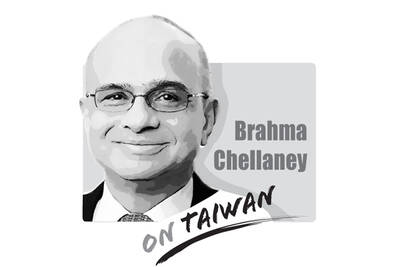In a perfectly apt scene involving barbed wire barricades and hundreds of police officers, National Taiwan Democracy Memorial Hall was restored yesterday to its original name, the Chiang Kai-shek Memorial Hall.
It was no small irony that the reversal occurred almost 22 years to the day since the lifting of martial law, declared in 1949 by dictator Chiang Kai-shek (蔣介石) himself. What followed were decades of the White Terror, during which thousands of Taiwanese and Chinese who opposed Chiang’s rule were murdered — both at home and abroad — or disappeared.
Some — ostensibly those who favor the renaming of the hall back to the name of a despot — argue that Chiang defended Taiwan and prevented the island being taken by the Chinese Communist Party (CCP) while slowly developing its economy.
If defending Taiwan and developing its economy were the prerequisites for naming the hall, then surely it should be called the United States Memorial Hall instead, given that it was US assistance in the form of the Mutual Defense Treaty, security guarantees and arms sales that gave Taiwan the space to grow.
In fact, Chiang’s adventurism and disconnect from reality — from his vow to retake the mainland by force to fanciful plans for entry into regional conflicts — created unnecessary danger for Taiwan and brought Asia closer to nuclear war.
The CKS Memorial, therefore, is not a means to honor a man who stood up for Taiwan, but rather a symbol of “one China.” Aside from an instrument to score political points domestically, the renaming of the monument by former president Chen Shui-bian’s (陳水扁) administration was an attempt to distance Taiwan from China by removing symbols of their supposed common destiny. In the process, Chen was also following a trend in co-opting memorials to antidemocratic leaders.
Back in China, the reviled Nationalist leader’s image has gradually been rehabilitated, so much so that in recent years there has been growing interest among domestic tourists in his refurbished former residence in Chongqing. Chinese tourists are also eager to visit his mausoleum in Taiwan. But Chiang’s rehabilitation in China is not the result of a decision by the CCP to “forgive” its old nemesis. It is, rather, part of Beijing’s strategy to narrow the divide between Taiwan and China and so bolster the image of a big happy Chinese family divided by Western and Japanese colonialism and the “unequal treaties.”
With the Chinese Nationalist Party (KMT) back in power, it is now the KMT’s turn to cater to its domestic constituency by renaming the hall. The party will also claim that the move is part of its policy of mending fences with Beijing — as if the CCP leadership cared what a block of granite in downtown Taipei is called.
More to the point, in renaming the hall, the KMT once again reaffirms its ideology as a party that sees Taiwan not as a sovereign entity, but rather as a part of China.
And so, the murderous little tyrant rears his ugly head once again, laughing at a people who suffered so much under his guard.
US President Donald Trump created some consternation in Taiwan last week when he told a news conference that a successful trade deal with China would help with “unification.” Although the People’s Republic of China has never ruled Taiwan, Trump’s language struck a raw nerve in Taiwan given his open siding with Russian President Vladimir Putin’s aggression seeking to “reunify” Ukraine and Russia. On earlier occasions, Trump has criticized Taiwan for “stealing” the US’ chip industry and for relying too much on the US for defense, ominously presaging a weakening of US support for Taiwan. However, further examination of Trump’s remarks in

As strategic tensions escalate across the vast Indo-Pacific region, Taiwan has emerged as more than a potential flashpoint. It is the fulcrum upon which the credibility of the evolving American-led strategy of integrated deterrence now rests. How the US and regional powers like Japan respond to Taiwan’s defense, and how credible the deterrent against Chinese aggression proves to be, will profoundly shape the Indo-Pacific security architecture for years to come. A successful defense of Taiwan through strengthened deterrence in the Indo-Pacific would enhance the credibility of the US-led alliance system and underpin America’s global preeminence, while a failure of integrated deterrence would
It is being said every second day: The ongoing recall campaign in Taiwan — where citizens are trying to collect enough signatures to trigger re-elections for a number of Chinese Nationalist Party (KMT) legislators — is orchestrated by the Democratic Progressive Party (DPP), or even President William Lai (賴清德) himself. The KMT makes the claim, and foreign media and analysts repeat it. However, they never show any proof — because there is not any. It is alarming how easily academics, journalists and experts toss around claims that amount to accusing a democratic government of conspiracy — without a shred of evidence. These
China on May 23, 1951, imposed the so-called “17-Point Agreement” to formally annex Tibet. In March, China in its 18th White Paper misleadingly said it laid “firm foundations for the region’s human rights cause.” The agreement is invalid in international law, because it was signed under threat. Ngapo Ngawang Jigme, head of the Tibetan delegation sent to China for peace negotiations, was not authorized to sign the agreement on behalf of the Tibetan government and the delegation was made to sign it under duress. After seven decades, Tibet remains intact and there is global outpouring of sympathy for Tibetans. This realization